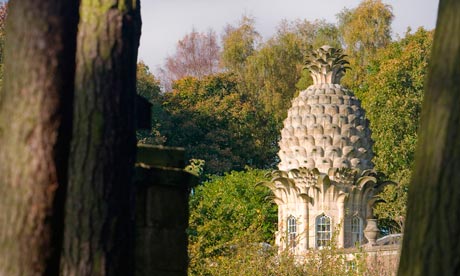
Distance 5 miles (8km)
Classification Moderate
Duration 2 hours 30 minutes
Begins The Pineapple car park
OS grid reference NS890884
Walk in a nutshell
The Pineapple, which has been owned by the National Trust for Scotland since 1973, is unquestionably an arresting focal point to the beginning and end of this lovely walk which travels along well-maintained woodland and countryside paths. The attractive village of Dunmore is also visited and there are some fine views of the river Forth and the rolling Ochil hills.
Why it's so special
Like all artistic undertakings, good architecture is meant to encourage debate and opinion; the bizarre, but undoubtedly eye-catching Pineapple will certainly get tongues wagging. Completely unique, the building was conceived by John Murray, the 4th Earl of Dunmore, as a fruity gift for his wife Charlotte in 1761.
Keep your eyes peeled for
The crumbling remains of Dunmore Tower, also known as Elphinstone Tower. This four-storey tower house was built circa 1510 for Sir John Elphinstone of Airth, whose family had acquired the estate by marriage in the early 14th century. George Murray, the 5th Earl of Dunmore (1762-1836), built Dunmore Park as his home around 1820, and for a time the basement of the old tower was used as the family mausoleum.
Recover afterwards
Airth Castle is a listed building and now houses a sumptuous hotel with cosy bars, a restaurant and even its own spa.
If it's tipping down
Only 9 miles away from Dunmore is the sumptuous Callendar House in Falkirk. Callendar House is the focal point of the extensive Callendar Park, and a tour around this beautiful house takes you through almost 600 years of Scottish history. Costumed interpreters recreate daily routines from the past, providing a superb interactive experience and an authentic insight into what life was really like for those who lived and worked in Callendar House.
How to get there
Buses run regularly from Stirling to Dunmore.
Step by step
1 From the left-hand side of the car park, follow the path down to the pond. Right of the viewing platform the path emerges on to the lawn facing the Pineapple. Left of the buildings, an arch in the brick wall surrounding the garden gives access to a woodland path. At a muddy path turn left and follow into open countryside. Pass through fields with fine views of the Ochil hills and the river Forth to reach the access road leading to the Pineapple car park.
2 Follow the access road left to a small house and a signposted track on the right. The track leads past the house beside the wall of an old garden to a signposted path junction. Turn right on to the path, descending to cross a burn, and emerging into open country, with Dunmore village visible on the right. Continue straight on to meet a track that enters more woodland.
3 Go straight on at the next junction (the path on the right is your return route from Dunmore village) to arrive at a tree-lined access road to Dunmore Home Farm. The road leads right to the main A905 road and offers views north-west of the Ochil hills.
4 Cross over the main road and continue on the access road to Dunmore Home Farm. Signs then point you along a continuation track, which emerges at the banks of the river Forth and Dunmore village.
5 Go through the village, passing the bowling green, to reach the main road. Cross over to follow the signposted route back to the main track.
6 Retrace your steps left to the track around the old walled garden and follow it to the right to a gateway inside, from where the car park is accessed to the left.

